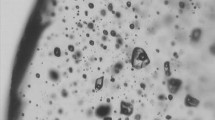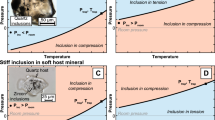Abstract
Fluid inclusions in quartz are known to modify their densities during shear deformation. Modifications of chemical composition are also suspected. However, such changes have not been experimentally demonstrated, their mechanisms remain unexplained, and no criteria are available to assess whether deformed inclusions preserve information on paleofluid properties. To address these issues, quartz crystals containing natural CO2–H2O–NaCl fluid inclusions have been experimentally subjected to compressive deviatoric stresses of 90–250 MPa at 700°C and ~600 MPa confining pressure. The resulting microcracking of the inclusions leads to expansion by up to 20%, producing low fluid densities that bear no relation to physical conditions outside the sample. Nevertheless, the chemical composition of the precursor inclusions is preserved. With time the microcracks heal and form swarms of tiny satellite inclusions with a wide range of densities, the highest reflecting the value of the maximum principle stress, σ 1. These new inclusions lose H2O via diffusion, thereby passively increasing their salt and gas contents, and triggering plastic deformation of the surrounding quartz via H2O-weakening. Using microstructural criteria to identify the characteristic types of modified inclusions, both the pre-deformation fluid composition and syn-deformation maximum stress on the host mineral can be derived from microthermometric analysis and thermodynamic modelling.











Similar content being viewed by others
References
Akinfiev NN, Diamond LW (2003) Thermodynamic description of aqueous nonelectrolytes at infinite dilution over a wide range of state parameters. Geochim Cosmochim Acta 67(4):613–629
Akinfiev NN, Diamond LW (2010) Thermodynamic model of aqueous CO2–H2O–NaCl solutions from −22 to 100°C and from 0.1 to 100 MPa. Fluid Phase Equilib (submitted)
Bakker RJ (1999) Adaptation of the Bowers and Helgeson (1983) equation of state to the H2O–CO2–CH4–N2–NaCl system. Chem Geol 154(1–4):225–236
Bakker RJ (2003) Package FLUIDS 1. Computer programs for analysis of fluid inclusion data and for modelling bulk fluid properties. Chem Geol 194:3–23
Bakker RJ, Diamond LW (2006) Estimation of volume fractions of liquid and vapor phases in fluid inclusions, and definition of inclusion shapes. Am Mineral 91:635–657
Bakker RJ, Jansen JBH (1990) Preferential water leakage from fluid inclusions by means of mobile dislocations. Nature 345:58–60
Bakker RJ, Jansen JBH (1991) Experimental post-entrapment water loss from synthetic CO2–H2O inclusions in natural quartz. Geochim Cosmochim Acta 55:2215–2230
Bakker RJ, Jansen JBH (1994) A mechanism for preferential H2O leakage from fluid inclusions in quartz, based on TEM observations. Contrib Mineral Petrol 116:7–20
Bodnar RJ, Sterner SM (1987) Synthetic fluid inclusions. In: Ulmer GC, Barnes HL (eds) Hydrothermal experimental techniques. Wiley, New York, pp 423–457
Bowers TS, Helgeson HC (1985) FORTRAN programs for generating fluid inclusion isochores and fugacity coefficients for the system H2O–CO2–NaCl at high pressures and temperatures. Comput Geosci 11:203–213
Cordier P, Doukhan JC (1989) Water in quartz; solubility and influence on ductility. Eur J Min 1:221–237
Cordier P, Doukhan JC (1995) Plasticity and dissociation of dislocations in water-poor quartz. Phil Mag A 72(2):497–514
Cordier P, Doukhan JC, Ramboz C (1994) Influence of dislocations on water leakage from fluid inclusions in quartz: a quantitative reappraisal. Eur J Min 6:745–752
Diamond LW (1990) Fluid inclusion evidence for P–V–T–X evolution of hydrothermal solutions in late-Alpine gold-quartz veins at Brusson, Val d’Ayas, Northwest Italian Alps. Am J Sci 290:912–958
Diamond LW (1992) Stability of CO2-clathrate-hydrate + CO2 liquid + CO2 vapour + aqueous KCl–NaCl solutions: experimental determination and application to salinity estimates of fluid inclusions. Geochim Cosmochim Acta 56:273–280
Diamond LW (1994) Salinity of multivolatile fluid inclusions determined from clathrate hydrate stability. Geochim Cosmochim Acta 58:19–41
Diamond LW (2001) Review of the systematics of CO2–H2O fluid inclusions. Lithos 55:69–99
Diamond LW (2003) Introduction to gas–bearing aqueous fluid inclusions. In Samson IM, Anderson AJ, Marshall DD (eds) Fluid inclusions: analysis and interpretation. Min Ass Canada, short course series volume 32:101–158
Duan ZH, Møller N, Weare JH (1995) Equation of state for the NaCl–H2O–CO2 system: prediction of phase equilibria and volumetric properties. Geochim Cosmochim Acta 59(14):2869–2882
Fitz Gerald JD, Boland JN, McLaren AC, Ord A, Hobbs BE (1991) Microstructures in water-weakened single crystals of quartz. J Geophys Res 96(B2):2139–2155
Gehrig M (1980) Phasengleichgewichte und PVT-Daten ternären Mischungen aus Wasser, Kohlendioxid und Natriumchlorid bis 3 kbar und 550°C. Doctoral Dissertation, Univ. Karlsruhe
Hall DL, Sterner SM (1993) Preferential water loss from synthetic fluid inclusions. Contrib Mineral Petrol 114:489–500
Hall DL, Sterner SM (1995) Experimental diffusion of hydrogen into synthetic fluid inclusions in quartz. J Metamorph Geol 13:345–355
Hollister LS (1988) On the origin of CO2-rich fluid inclusions in migmatites. J Metamorph Geol 6:467–474
Hollister LS (1990) Enrichment of CO2 in fluid inclusions in quartz by removal of H2O during crystal-plastic deformation. J Struct Geol 12(7):895–901
Hosieni KR, Howald RA, Scanlon MW (1985) Thermodynamics of the lambda transition and the equation of state of quartz. Am Mineral 70:782–793
Johnson EL, Hollister LS (1995) Syndeformational fluid trapping in quartz: determining the pressure–temperature conditions of deformation from fluid inclusions and the formation of pure CO2 fluid inclusions during grain-boundary migration. J Metamorph Geol 13:239–249
Klemd R, Oberthür T, Ouedraogo A (1997) Gold-telluride mineralisation in the Birimian at Diabatou, Burkina Faso: the role of CO2–N2 fluids. J Afr Earth Sci 35:199–211
Kronenberg AK (1994) Hydrogen speciation and chemical weakening of quartz. Rev Mineral Geochem 29(1):123–176
Kronenberg AK, Kirsby SH, Aines RD, Rossman GR (1986) Solubility and diffusional uptake of hydrogen in quartz at high water pressures: implications for hydrolytic weakening. J Geophys Res 91:12723–12744
Krüger Y, Diamond LW (2001) P–V–T–X properties of two H2O–CO2–NaCl mixtures up to 850°C and 500 MPa: results of a synthetic fluid inclusion study. ECROFI-XVI (Porto, Portugal) Abstracts volume 241–243
Küster M, Stöckhert B (1997) Density changes of fluid inclusions in high-pressure low-temperature metamorphic rocks from Crete: a thermobarometric approach based on the creep strength of the host minerals. Lithos 41:151–167
Lamb WM, Moecher DP (1992) CO2-rich fluid inclusions in the Whitestone Anorthosite: retrograde formation and subsequent modification. J Metamorph Geol 10:763–776
Mavrogenes JA, Bodnar RJ (1994) Hydrogen movement into and out of fluid inclusions in quartz—experimental evidence and geologic implications. Geochim Cosmochim Acta 58:141148
McLaren AC, Cook RF, Hyde ST, Tobin RC (1983) The mechanisms of the formation and growth of water bubbles and associated dislocation loops in synthetic quartz. Phys Chem Min 9:79–94
McLaren AC, Fitzgerald JD, Gerretsen J (1989) Dislocation nucleation and multiplication in synthetic quartz: relevance to water weakening. Phys Chem Min 16:465–482
Morgan GB, Chou IM, Pasteris JD, Olsen SN (1993) Re-equilibration of CO2 fluid inclusions at controlled hydrogen fugacities. J Metamorph Geol 11:155–164
Peng DY, Robinson DB (1976) A new two-constant equation of state. Ind Eng Chem Fundam 15(1):59–64
Ridley J, Hagemann SG (1999) Interpretation of post-entrapment fluid-inclusion re-equilibration at the Three Mile Hill, Marvel Loch and Griffins find high-temperature lode-gold deposits, Yilgarn Craton, Western Australia. Chem Geol 154:257–278
Schmidt Mumm A, Oberthür T, Vetter U, Blenkinsop TG (1997) High CO2 content of fluid inclusions in gold mineralisations in the Ashanti Belt, Ghana: a new category of ore forming fluids? Min Depos 32:107–118
Schmidt C, Bruhn D, Wirth R (2003) Experimental evidence of transformation plasticity in silicates: minimum of creep strength in quartz. Earth Planet Sci Lett 205:273–280
Schwartz MD, Oberthür T, Amanor J, Gyapong W (1992) Fluid inclusion re-equilibration and P–T–X constraints on fluid evolution in the Ashanti gold deposit. Eur J Min 4:1017–1033
Sterner SM, Bodnar RJ (1989) Synthetic fluid inclusions—VII. Re-equilibration of fluid inclusions in quartz during laboratory-simulated metamorphic burial and uplift. J Metamorph Geol 7:243–260
Sterner SM, Hall DL, Keppler H (1995) Compositional re-equilibration of fluid inclusions in quartz. Contrib Mineral Petrol 119:1–15
Tarantola A, Diamond LW, Stünitz H (2010) Modification of fluid inclusions in quartz by deviatoric stress. I: experimentally induced changes in inclusion shapes and microstructures. Contrib Mineral Petrol. doi:10.1007/s00410-010-0509-z
Vityk MO, Bodnar RJ, Doukhan J-C (2000) Synthetic fluid inclusions: XV. TEM investigation of plastic flow associated with reequilibration of synthetic fluid inclusions in natural quartz. Contrib Mineral Petrol 139:285–297
Acknowledgments
This study was supported by Swiss National Science Foundation grants 200020-111834 and 200020-122131 to L. W. Diamond. Anina Caviezel kindly assisted with spindle-stage measurements. The authors are grateful to two anonymous journal reviewers for their helpful comments and to Jacques Touret for editorial advice.
Author information
Authors and Affiliations
Corresponding author
Additional information
Communicated by J.L.R. Touret.
Electronic supplementary material
Below is the link to the electronic supplementary material.
Appendices
Appendix 1: Measurement of volume fraction of carbonic phase in a precursor inclusion
Following the method of Bakker and Diamond (2006), the volume fraction of the carbonic phases in an example precursor inclusion can be determined from the two data plots in Fig. 12. Figure 12a displays triplicate measurements of the total projected area of the inclusion as a function of rotation angle of the spindle stage. Figure 12b displays triplicate measurements of the area fraction of the carbonic phase as a function of rotation angle of the spindle stage. The maximum in the data array in Fig. 12a lies at the rotation angle 12.5° (marked by an arrow). This angle, when intersected with the area-fraction curve in Fig. 12b, indicates the area fraction (0.193) which most closely approximates the numerical value of the volume fraction. The method carries an uncertainty of ±4% relative. Thus, the result for this example is φ(car) = 0.193 ± 0.008.
Estimation of the volume fraction of the carbonic phase, φ(car), at room temperature in an example inclusion using the method of Bakker and Diamond (2006). a Projected area of the inclusion versus angle of rotation in the spindle stage. b Area fraction of the carbonic phase versus angle of rotation in the spindle stage. See text for explanation
Appendix 2: Calculation of relationship between V m(car) and φ(car) for an expanding fluid inclusion
To test the hypothesis that the relict fluid inclusions have expanded their volumes at constant composition, the relationship between the observable parameters V m(car) and φ(car) can be calculated as a function of volume expansion. For a fluid inclusion of fixed composition, the mole fraction of carbonic phase can be obtained by rearranging Eq. 5:
This value can be inserted into a rearrangement of Eq. 2 to yield the molar volume of the carbonic phase:
where for simplification V m(aq) is held constant. Input values of V m(tot) are generated by multiplying the initial (measured) V m(tot) by an arbitrary factor to simulate expansion of the inclusion volume. For example, 10% expansion increases an initial V m(tot) of 22 cm3 mol−1 to a final V m(tot) of 24.2 cm3 mol−1. Solution of Eq. 10 for a range of V m(tot) yields the model relationship between V m(aq) and the hypothesized volume expansion (curve in Fig. 11b).
Inserting the appropriate constant V m(aq) and the V m(car) value calculated from Eq. 10 into the following expression (Eq. 5 in Diamond 2001):
yields the model relationship between V m(car) and φ(car) (curve in Fig. 11a), which can be compared with the observations.
Rights and permissions
About this article
Cite this article
Diamond, L.W., Tarantola, A. & Stünitz, H. Modification of fluid inclusions in quartz by deviatoric stress. II: experimentally induced changes in inclusion volume and composition. Contrib Mineral Petrol 160, 845–864 (2010). https://doi.org/10.1007/s00410-010-0510-6
Received:
Accepted:
Published:
Issue Date:
DOI: https://doi.org/10.1007/s00410-010-0510-6





